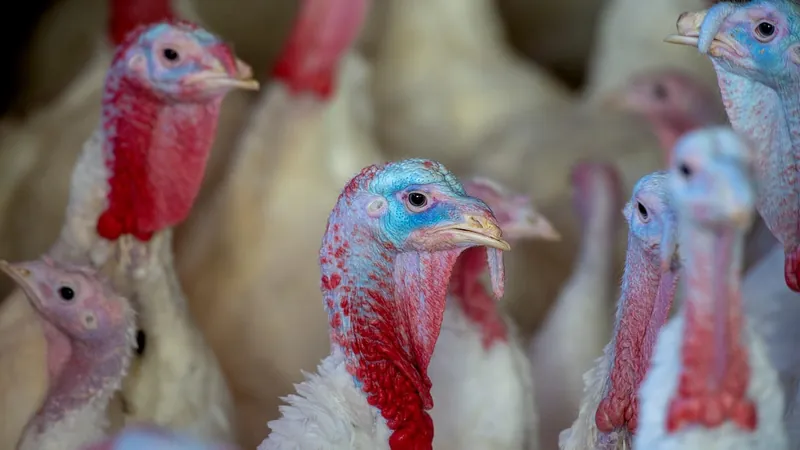
Avian Influenza Crisis: Unraveling the Impact on Poultry, Dairy, and Your Wallet!
2024-11-21
Author: Sophie
Introduction: The Ongoing Bird Flu Battle
Since 2022, the highly pathogenic avian influenza (HPAI) has wreaked havoc on the poultry industry, and more recently dairy farms, affecting over 100 million birds and forcing farmers to grapple with significant challenges. As of March 2024, dairy cattle have also been implicated in this ongoing crisis, leading to a surge in severe economic repercussions for farmers and consumers alike.
Poultry Under Siege: The Troubling Reality
The surge in HPAI cases is alarming—73 million egg-laying hens and 14.2 million turkeys have been impacted as of October 2024. In fact, just this past month, California reported the detection of HPAI in two commercial broiler flocks, contributing to the distress of an industry already on the ropes. While broiler flocks have remained somewhat insulated from the virus due to geographic factors, the overall trend is concerning. Egg prices have skyrocketed, with average retail prices hitting a staggering $4.82 per dozen as recently as January 2023. Although prices have dipped to about $2.99 per dozen by September 2024, volatility remains a major concern.
Turkey Production Takes a Hit
The repercussions extend to turkey production as well. Amid declining consumer demand and the impacts of HPAI, turkey farmers expect a significant production drop in 2024—a concerning 6.3% decline from the previous year—resulting in the lowest turkey production levels since 1985. As American appetite shifts toward alternative meats, the average wholesale price for frozen whole hen turkeys plummeted nearly 23% compared to September 2023.
Dairy Cattle: A New Affliction?
Last year marked a troubling first: HPAI was detected in dairy herds, particularly affecting lactating cattle. Symptoms include reduced milk yield and changes in milk quality. With California reporting the majority of cases and the virus primarily spreading through shared equipment and personnel, concerns regarding safe practices in dairies are heightened. Thankfully, the general public is reportedly at low risk, with pasteurization effectively neutralizing the virus.
Government Actions to Combat HPAI
In response to the escalating crisis, the USDA has implemented critical measures, such as mandatory testing and reporting for dairy cattle, alongside significant funding to bolster livestock health efforts. The development of a voluntary Dairy Herd Status Program aims to improve the situation further, allowing farmers to maintain herd movement freedoms under specific testing protocols.
Financial Relief for Farmers
To further support those impacted, the USDA recently introduced new financial assistance provisions for dairy farmers facing milk losses due to HPAI. Thus far, this initiative has provided $18 million in aid to over 100 dairy farmers.
Hope on the Horizon: Vaccines in Development?
Promising news is on the horizon as research for an HPAI vaccine for cattle has commenced, with several candidates now progressing to safety trials. While this could pave the way for more effective response strategies in the future, the challenges posed by HPAI are expected to persist.
Conclusion: Ongoing Vigilance Needed
As the HPAI landscape continues to evolve, both the poultry and dairy industries must remain vigilant. The public can take comfort in knowing that the U.S. food supply remains safe, but with fluctuating prices for eggs and turkey looming, it’s evident we haven’t seen the last of this crisis. Stay informed, and brace yourself for continuing developments that could impact your grocery bill!
Stay tuned for more updates on this crucial issue and learn how it could affect your holiday plans.









 Brasil (PT)
Brasil (PT)
 Canada (EN)
Canada (EN)
 Chile (ES)
Chile (ES)
 España (ES)
España (ES)
 France (FR)
France (FR)
 Hong Kong (EN)
Hong Kong (EN)
 Italia (IT)
Italia (IT)
 日本 (JA)
日本 (JA)
 Magyarország (HU)
Magyarország (HU)
 Norge (NO)
Norge (NO)
 Polska (PL)
Polska (PL)
 Schweiz (DE)
Schweiz (DE)
 Singapore (EN)
Singapore (EN)
 Sverige (SV)
Sverige (SV)
 Suomi (FI)
Suomi (FI)
 Türkiye (TR)
Türkiye (TR)